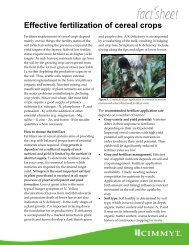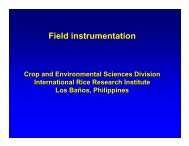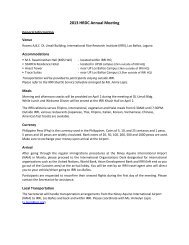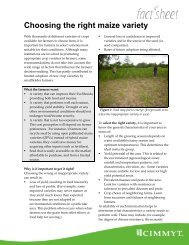Water management in irrigated rice - Rice Knowledge Bank ...
Water management in irrigated rice - Rice Knowledge Bank ...
Water management in irrigated rice - Rice Knowledge Bank ...
- No tags were found...
Create successful ePaper yourself
Turn your PDF publications into a flip-book with our unique Google optimized e-Paper software.
Table 1.1. Total seasonal water <strong>in</strong>put and daily seepage and percolation rates from lowland <strong>rice</strong> fields with cont<strong>in</strong>uouslyponded water conditions. Data collected from field experiments and from farmers’ fields <strong>in</strong> Ch<strong>in</strong>a and the Philipp<strong>in</strong>es.Total seasonal water Seepage andSite <strong>in</strong>put by ra<strong>in</strong> plus percolation Referencesirrigation (mm) rate (mm d −1 )Zanghe Irrigation System, Hubei, Ch<strong>in</strong>a• Field experiment 750 to 1,110 4.0 to 6.0 Cabangon et al (2001, 2004)• Farmers’ fields 650 to 940 1.6 to 2.8 Dong et al (2004), Loeve et al (2004a,b)• Irrigation system level 750 to 1,525 4.0 to 8.0 Dong et al (2004), Loeve et al (2004a,b)Shimen, Zhejiang, Ch<strong>in</strong>a Cabangon et al (2001, 2004)• Early <strong>rice</strong> 850 to 950 1.0 to 6.0• Late <strong>rice</strong> 575 to 700 1.0 to 6.0Guimba, Philipp<strong>in</strong>es Tabbal et al (2002)• Experiment 1988 2,197 18.3• Experiment 1989 1,679 12.5• Experiment 1990 2,028 16.4• Experiment 1991 3,504 32.8Muñoz, Philipp<strong>in</strong>es, 1991 1,019 to 1,238 5.2 to 7.0 Tabbal et al (2002)Muñoz, Philipp<strong>in</strong>es, 2001 600 1.1 to 4.4 Belder et al (2004)Talavera, Philipp<strong>in</strong>es 577 to 728 0.3 to 2.0 Tabbal et al (2002)San Jose, Philipp<strong>in</strong>es Tabbal et al (2002)• Experiment 1996 1,417 9.6• Experiment 1 1997 1,920 15.2• Experiment 2 1997 2,874 25.8withdraws water from the puddled layer. S<strong>in</strong>ce theroots of <strong>rice</strong> plants generally don’t penetrate thecompacted layer, the contribution to transpirationfrom the subsoil is mostly absent. S<strong>in</strong>ce evaporationand transpiration are difficult to measure separately<strong>in</strong> the field, they are usually taken together as “evapotranspiration.”Typical evapotranspiration ratesof <strong>rice</strong> fields are 4–5 mm d –1 <strong>in</strong> the wet season and6–7 mm d –1 <strong>in</strong> the dry season, but can be as highas 10–11 mm d –1 <strong>in</strong> subtropical regions (Tabbalet al 2002). Dur<strong>in</strong>g the crop growth period, about30–40% of evapotranspiration is evaporation (Boumanet al 2005, Simpson et al 1992).Seepage is the subsurface flow of waterunderneath the bunds of a <strong>rice</strong> field. With wellma<strong>in</strong>ta<strong>in</strong>edbunds, seepage is generally small. In atoposequence of <strong>rice</strong> fields, seepage loss from onefield may be offset by <strong>in</strong>com<strong>in</strong>g seepage from anotherfield located higher up. Considerable seepagecan occur from top-end fields and from bottom-endfields that border dra<strong>in</strong>s, ditches, or creeks. Seepagerates are affected by the soil physical characteristicsof the field and bunds, by the state of ma<strong>in</strong>tenanceand length of the bunds, and by the depth of thewater table <strong>in</strong> the field and <strong>in</strong> the surround<strong>in</strong>g dra<strong>in</strong>s,ditches, or creeks (Wickham and S<strong>in</strong>gh 1978).Percolation is the vertical flow of water to belowthe root zone. The percolation rate of <strong>rice</strong> fieldsis affected by a variety of soil factors (Wickhamand S<strong>in</strong>gh 1978): structure, texture, bulk density,m<strong>in</strong>eralogy, organic matter content, and salt typeand concentration. Soil structure is changed by thephysical action of puddl<strong>in</strong>g. In a heavy-textured,montmorillonitic clay, sodium cations and a highbulk density are favorable for effective puddl<strong>in</strong>gto reduce percolation rates. The percolation rate isfurther <strong>in</strong>fluenced by the water regime <strong>in</strong> and aroundthe field. Large depths of ponded water favor highpercolation rates (Sanchez 1973, Wickham andS<strong>in</strong>gh 1978). In a field survey <strong>in</strong> the Philipp<strong>in</strong>es,Kampen (1970) found that percolation rates werehigher for fields with deep groundwater tables (> 2m depth) than for fields with shallow groundwatertables (0.5–2 m depth). In practice, seepage andpercolation flows are not easily separated becauseof transition flows that cannot be classified as eitherpercolation or seepage (Wickham and S<strong>in</strong>gh 1978).Typical comb<strong>in</strong>ed values for seepage and percolationvary from 1–5 mm d –1 <strong>in</strong> heavy clay soils to25–30 mm d –1 <strong>in</strong> sandy and sandy loam soils (Boumanand Tuong 2001). Some examples of seepageand percolation rates measured at different sites are





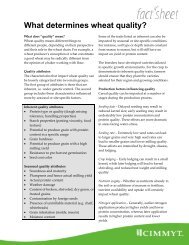

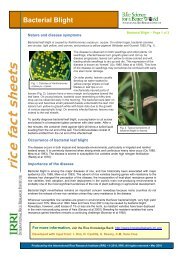

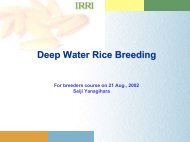
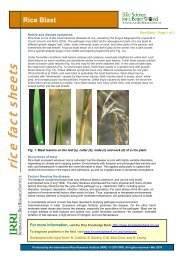
![International Standards' Organization â Rice Specification [ISO 7301]](https://img.yumpu.com/36696862/1/190x245/international-standards-organization-a-rice-specification-iso-7301.jpg?quality=85)

